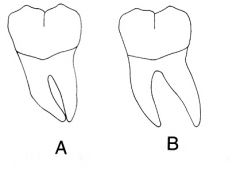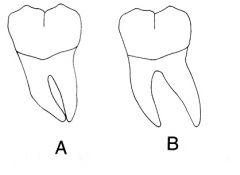![]()
![]()
![]()
Use LEFT and RIGHT arrow keys to navigate between flashcards;
Use UP and DOWN arrow keys to flip the card;
H to show hint;
A reads text to speech;
19 Cards in this Set
- Front
- Back
|
What are the types of bridges?
|
Conventional tooth supported
Resin-bonded tooth supported |
|
|
Indications for conventional tooth supported bridges?
|
Posterior span 2 missing teeth or fewer
Incisors: 4 missing teeth or fewer Abutments are periodontally sound Edentulous span short and straight |
|
|
Indications for resin-bonded tooth supported?
|
Single missing tooth
Possible for 2 incisors Younger patients (large pulps) Not fully developed muscles of mastication |
|
|
Indications for Removable Partial denture?
|
Edentulous space:
- posterior: > 2 - anterior: > 4 incisors - canine: with 2 contiguous teeth - no distal abutment (cantilever) - multiple spaces Abutment Tipped teeth Divergent alignments Periodontally weakened primary abutments Teeth with short clinical crown Insufficient number of abutments Cost |
|
|
Indications for implant-supported fixed partial denture
|
Single tooth
2 - 6 unit span pier in a pontic span Inadequate strength in the abutments Insufficient no. of abutment teeth Span length limited by availability of alveolar bone (density and thickness) |
|
|
What are the components of bridge?
|
Retainer
Connector Pontic |
|
|
Types of connectors in bridges?
|
Rigid
Non rigid |
|
|
What are the important factors when it comes to Pontics in bridges?
|
Cleansability
Appearance Strength |
|
|
What are the abutment considerations?
|
Crown-root ratio
Root configuration Periodontal ligament area |
|
|
What is the ideal crown:root ratio?
|
2 crown: 3 root
|
|

Which root configuration is more ideal?
|
A
|
|

Which root-configuration is more ideal?
|
B
|
|
|
What is Ante's law?
|
The root surface area of abutment hast to be equal or greater than the teeth being replaced with pontics
|
|
|
What are the biomechanical considerations?
|
1 deflection of a fixed partial denture is proportional to cube of the length
2 Defelction of a fixed partial denture inversely proportional to cube of the occlusogingival thickness |
|
|
What are the types of bridges?
|
Fixed-fixed
Fixed-movable Cantilever Resin-bonded (Maryland) Combination design |
|
|
Fixed-fixed bridge
Pros and cons |
ADVANTAGES
• Maximum retention and strength • Abutment teeth are splinted together • Larger bridges • Construction straightforward in the laboratory (no movable joints) DISADVANTAGES • Preparations slow and difficult: parallelism • More tooth reduction: endanger pulp, less retention, extensive destruction • Cementation difficult (in one piece) |
|
|
Fixed-movable bridge
Pros and cons |
ADVANTAGES
• Preparations do not need to be parallel – abutments can be divergent • Abutments with independent design – more retentive • Preparation less destructive • Allows minor movements of teeth • Cementation easy DISADVANTAGES • Length of span limited • Complicated to construct (laboratory) • Difficult to make temporary |
|
|
Cantilever bridge
Pros and cons |
ADVANTAGES
• Most conservative design • 1 abutment = no need of parallelism • 2 or more abutments = teeth adjacent – easier to prepare • Easier maintenance and cleaning • Construction straightforward in the laboratory DISADVANTAGES • Relatively small retentive area • Vulnerable to debonding through torquing forces • Construction of the bridge must be rigid to avoid distortion |
|
|
Resin-bonded bridge (Maryland Bridge)
Pros and cons |
ADVANTAGES
• Pulp is not at risk from the preparation • Technique mostly reversible • Temporary restorations are not required • Generally less expensive than conventional bridges DISADVANTAGES • Thickness of tooth is increased • Retainer produce ledge – plaque accumulation • Short survival |

